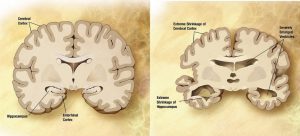Extensive Alzheimer’s study hopes to speed the advancement of research
A recent study published in Communications Biology may increase the rate of progress of Alzheimer’s research by providing a very large dataset of differences between healthy and Alzheimer’s disease brains. The dataset has been provided online for any researcher to access free of charge. Funded by Alzheimer’s Research UK, the team included scientists from the Universities of Manchester, Liverpool, Bristol and Auckland all collaborating.

Healthy (left) compared to Alzheimer’s disease brain (right).
Alzheimer’s disease is a neurogenerative disorder that worsens over time and is the cause of the majority of dementia cases. Patients initially experience short-term memory loss followed by disorientation, language problems, behavioral issues, and a decrease in self-care. Alzheimer’s sufferers often require a large amount of care posing a serious public health burden. According to the United States Centers for Disease Control (CDC), more than 5 million Americans suffered from Alzheimer’s in 2014.
Led by Dr. Richard Unwin of the University of Manchester, the scientists studied brains donated by patients at the New Zealand Brain Bank in Auckland. They compared and mapped the relative levels of 5,825 proteins across six regions of the human brain. More than 24,000 data points were generated to contrast healthy and Alzheimer’s diseased brains. Regions of the brain most affected by the disease include the hippocampus, cingulate gyrus and entorhinal cortex. Regions less affected are the cerebellum, motor cortex and sensory cortex.
In all, the team found alterations in 129 proteins located in all areas of the brain in Alzheimer’s patients compared to those without the disease. Forty-four of these proteins had not been indicated to be associated with Alzheimer’s in the past. According to Dr. Unwin, “Changes we see in the regions affected later-on represent early disease changes, present before cells die. These represent good new targets for drug developers, as we know it’s important to try to intervene early.” Furthermore, pathways currently suspected for involvement with Alzheimer’s, including Wnt signaling and inflammation, were identified in this study.
With the public’s access to the study’s data, hopes are that researchers can build on this work and find better treatments or a cure for Alzheimer’s disease, as it is predicted to affect more than 14 million Americans alone by the year 2060.
Do you work in neurobiology? The Kerafast catalog has a variety of neuroscience reagents for your research; the catalog grows weekly, so search for unique reagents frequently! Our Alzheimer’s disease-related reagents currently include:
- C-DAG Amyloidogenicity Kit from Harvard University
- Hyperphosphorylated Microtubule-Associated Protein Tau from Michigan State University
- Amyloid Beta Peptide, Pan-Specific [MOAB-2] Antibody from University of Illinois at Chicago
- Nitrated and Phosphorylated Amyloid Beta Antibodies from University of Bonn


